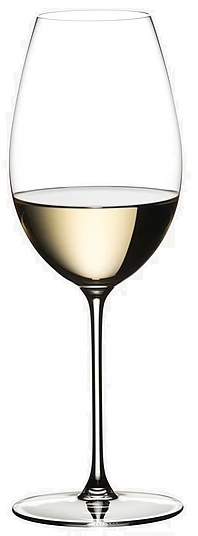Selecting the Right Glass
Selecting the right wine glass can enhance your wine-drinking experience by allowing the wine to express its full range of aromas and flavors.
Different types of wine glasses are designed to complement specific wine varietals. The key is to ensure that the glass allows the wine to circulate properly, directs the aromas toward your nose, and enhances your overall enjoyment of the wine.
Personal preferences also play an important role. You can choose the glass that best suits your taste.
Red Wines
The Universal Glass

|
The Universal Glass is designed to enhance the overall drinking experience for a wide range of red wine varieties. It typically has a bowl shape with a wider base that narrows towards the top, allowing for better circulation and concentration of aromas. |
The Burgundy Glass
The Burgundy Glass is for swirling & releasing the wine aromas.

|
The shape of the glass captures and directs the delicate aromas to your nose
and leads the wine to the tip of your tongue for a better reception of the tastes.
The Burgundy glass was designed for the delicate and aromatic red wine Bourgogne Rouge, made from Pinot Noir grapes in Bougogne (Burgundy). |
The Bordeaux Glass
The Bordeaux Glass was designed for enjoying fuller-bodied, tannic red wines.

|
They are taller than other red wine glasses, and has a slimmer bowl.
The slimmer bowl directs the wine to the back of your mouth for a maximum taste. The size also allows the bouquet of the wine to develop, smooth out rough edges, play down tannins, and allow the wine to achieve balance. |
The Syrah Glass

|
These glasses have a more tapered bowl compared to Bordeaux glasses. They are designed to enhance the bold and spicy characteristics of Syrah or Shiraz wines. |
White Wines
The Universal Glass
A Tulip Shaped Glass with a slightly smaller bowl can be suitable for various dry white wines.

|
The glass guides the wine to the center of your mouth, avoiding the sides where acidity is less pleasant.
A smaller bowl also helps to serve smaller quantities, and keep the wine cold. It also helps if you hold the glass by the stem! |
The Chardonnay Glass
The Chardonnay Glass was designed for enjoying full-bodied white wines. They have a wider bowl and a tapered top to enhance the buttery and oaky notes found in aged wines.

|
The wide bowl steers the wine to the sensitive parts of the tongue, ensuring that the acidity creates a harmonious balance with the sweet aromas of the wine. The wide bowl allows the full bouquet of aromas to develop. It also reduces the risk for over-concentrated aromas. |
The Sauvignon Blanc Glass

|
The Sauvignon Blanc glass is smaller than a Chardonnay glass.
It has a more narrow bowl to concentrate the crisp and citrusy aromas of a zesty and fruity white wine. |
The Riesling Glass
A Riesling Glass has a tall and narrow bowl to emphasize the aromas of the wine.

|
The shape also helps balance the high acidity often found in .
The Riesling glass is perfect for any bone dry wines with high acidity like Chablis, Chenin Blanc, Picpoul and Vinho Verde. |
Sparkling Wines

|
The Flute GlassFlute glasses are commonly used for Champagne and other sparkling wines. The elongated shape helps preserve the bubbles and allows for a more gradual release of carbonation. |

|
The Tulip GlassSome prefer tulip-shaped glasses for sparkling wines, as they provide a larger surface area for the wine to breathe while still maintaining CO2. |
Dessert Wines

|
Small Tulip or Port GlassFor sweet and fortified wines like Port or Sauternes, a smaller tulip-shaped glass is often used. This concentrates the rich flavors and aromas. |